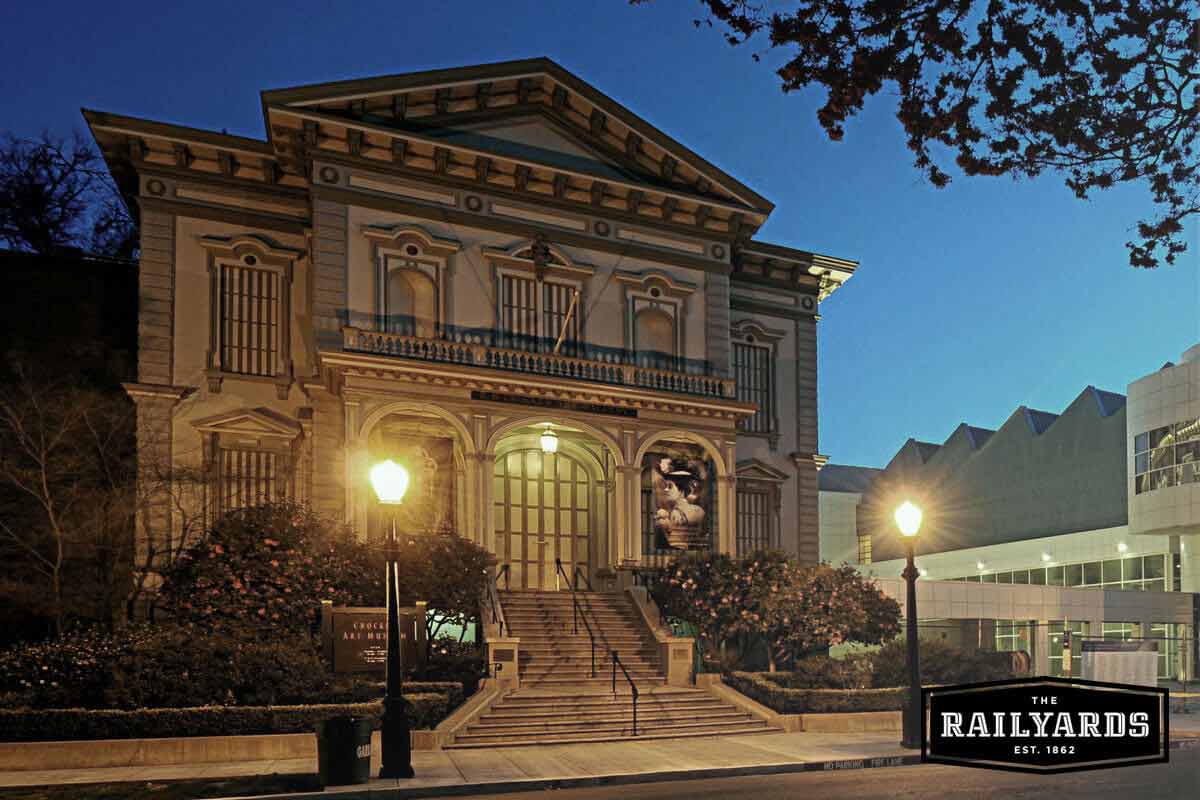
May 10, 2024 / Author: the Railyards
While these women’s contributions to Sacramento history are quite different, they have one thing in common: their legacies will never be forgotten.
Countless women have impacted Sacramento’s rich, storied past. From 17th-century pioneers to modern-day politicians and everything in between, the capitol of California wouldn’t be the place it is today were it not for the women who helped shape it.
Sacramento Women in History
Luella Johnston: California’s First Woman in Office
The first woman elected to City Council’s office in California, Luella Johnston, may also have been the first woman elected to any public office in any United States city.
Born in New Hampshire in 1861, Luella moved West to California as a child and, as a teenager, became a schoolteacher in San Francisco before marrying Alfred Johnston, a man who ran a printing press in Sacramento.
His successful business landed him an appointment as the Superintendent of State Printing, a position that was soon made an elected office, which he won.
The social standing and political affiliation associated with Johnston’s office put Luella right in the heart of Sacramento society.
First known as a socialite who created the Club of ‘99, a social club almost considered frivolous, Luella went on to help transform what had been a local women’s reading group into The Tuesday Club. Under her presidency, the group changed its purpose, updating its mission statement to reflect that its cause was now to ‘encourage all movements for the betterment of society.’
The Tuesday Club was an important political player in Sacramento. It helped implement lasting changes in the region, from the creation of new parks—including McKinley Park—to the banning of new bars in residential areas.
Other women’s groups in the area were inspired by these accomplishments and jumped into action, which led Luella to form The Woman’s Council in 1904.
Bringing together 30 women’s clubs in the region to work towards common civic goals, The Woman’s Council immediately began to change the face of Sacramento. During her time as president, the council created a new high school, added a receiving matron for the city hospital, and added nameplates to every city street. The list goes on to include street electrification, installation of public drinking fountains and residential mailboxes, building a public swimming pool, and more.
Also a leader in the local suffragette movement, Luella played an important role in helping win women the right to vote in California, which was a pivotal point on the road to eventually winning the right to vote on the national level.
Her accomplished civic work, coupled with her experience in successful political campaigning, prepared her to run for City Council in 1912.
In addition to receiving public support from these organizations, Luella utilized her polished skills in organizing and campaigning for her benefit. She had an army of women behind her candidacy, handing out endorsement cards and rallying women to the polls on election day.
An instrumental player in women winning the vote in California and a catalyst for civic change and advancement, Luella Johnston’s election to Sacramento’s City Council in 1912 was a landmark victory that opened the door for women in politics and cemented her place in Sacramento’s history.
In 2018, Luella Johnston’s distinctive accomplishments were honored by the City of Sacramento.
On October 16th, the Historic City Hall Hearing Room was renamed the Luella Johnston Hearing Room, a fitting honor for the first woman to sit on the City Council in that very room.
“We want Luella’s memory to remind everyone of all of those women over 100 years,” Councilmember Angelique Ashby said. “And even more importantly to inspire the next 100 years of women who will serve in the city of Sacramento.”
Margaret Crocker: Sacramento Philanthropist and Benefactor of the Arts
A philanthropist whose kindness, generosity, and gift of art left an indelible mark on Sacramento.
Born in Ohio and living in Indiana as a child, Margaret moved to California with her husband, Edwin Crocker, to join his brothers, who had found success as merchants in Gold Rush-era Sacramento.
When the Crocker family settled in Sacramento, they faced fire and flood, and a lot set them back, but nothing ever stopped them. The Crockers endured hardship with a pioneer spirit and triumphantly rose from every challenge.
An attorney by trade, Edwin was a catalyst in the formation of the California Republican Party and an active politician. In 1856, he formed the Republican Club along with his brother Charles, Mark Hopkins, Collis Huntington, and Leland Stanford. The founding members of this club – Edwin aside – would go on to alter both California and United States history as the Big Four: the men responsible for the facilitation and creation of the Central Pacific Railroad.
While Edwin provided counsel for these men, he had a long, successful career as a well-respected attorney and, later, judge.
In the meantime, Margaret had established a reputation of her own for her charitable donations.
Margaret always enjoyed helping others. She was known for taking food and flowers from her garden to the homes of the needy or ill.
Art lovers both, the Crockers returned from a two-year trip abroad with four railroad cars of drawings and paintings and immediately began construction on a large-scale gallery attached to their home that included a ballroom, ornate library, billiards room, bowling alley, and skating rink.
After Judge Crocker’s passing, Margaret began to emerge as both a civic and social leader and an active philanthropist.
Responsible for the construction of both the Bell Conservatory – an immense greenhouse located at 9th, 10th, and X and Y Streets, which was a smaller-scale version of the conservatory in San Francisco’s Golden Gate Park – and the Marguerite Home for Aged Women at 7th and Q Streets – a home for aging women who were unable to provide for themselves – Margaret became known as “Lady Bountiful.”
Margaret temporarily opened her personal gallery as a site for a very successful exhibition of the California Museum Association, which led to her decision to permanently gift her art gallery and collection to them for the benefit of the general public.
While her charity and kindness will never be forgotten, her most lasting legacy is the gift of art she left to her city.
The Crocker Art Museum has earned accreditation by the American Alliance of Museums—a recognition bestowed upon less than 1,100 of the nation’s museums—for its world-renowned collection of California art and European master drawings.
Furthermore, it welcomes more than 300K visitors through its doors per year, placing it among the top 50 most-visited museums in North America.
The gifts that Margaret Crocker left to Sacramento after her passing and the love and kindness she bestowed upon it during her life have forever earned her a special place in the heart of Sacramento’s history.
Elizabeth Thorn Scott Flood, the Mother of Desegregated CA Children’s Education:
Elizabeth Scott Flood, born Elizabeth Thorn around 1828 in New York and educated in New Bedford, Massachusetts, moved to California as a young widow after the death of her first husband, Joseph Scott, a gold miner.
Once in California, Scott realized her son was not allowed to attend Sacramento’s public school. After noticing the sizable black community that existed there and in the neighboring city of San Francisco, Scott knew that she had to make a change.
After being faced with discrimination, Scott swiftly took up the mantle of educator and activist, dedicating her life to the pursuit of equal education for all children, regardless of race.
With support from Saint Andrews African Methodist Episcopal Church, she established a school for African-American children in her home in 1854.
Initially catering to African American students, her school soon embraced children of Native American and Asian descent, demonstrating her inclusive vision. The school was unique not only for its diversity but also for its range of student ages, welcoming those from four to twenty-nine.
Elizabeth’s activism extended beyond her classroom.
In 1855, she attended the first California State Convention of Colored Citizens, where the state’s African American community sought greater civil rights and representation. That same year, she married Isaac Flood, a freed slave twelve years her senior.
Together, they became pillars of the community in Brooklyn, now part of Oakland, California. By 1857, the couple had opened another school for African American children in their new home, contributing significantly to local educational reform.
Not only was Elizabeth impactful, but the entire Flood family’s contributions were also foundational, with Elizabeth continuing to teach until her sudden death in 1867.
Although she did not live to see the desegregation of schools, her persistent advocacy laid the groundwork for future changes. Following her passing, public schools in Brooklyn, soon annexed by Oakland, began admitting African American students in 1872.
Elizabeth’s daughter, Lydia Flood Jackson, became one of the first African American students to attend these integrated schools. By 1880, California law mandated school integration, a testament to the impact of Elizabeth Thorn Scott Flood’s fight for equal education.
Mary Gregory Park - One of Sacramento’s Earliest Businesswomen
Mary Gregory, an influential businesswoman in early Sacramento, played a significant role in the economic development of the city during the mid-1800s. English-born Gregory moved to Sacramento with her husband in the 1850s. Together, they ran a successful business at 126 J Street, selling produce and local products. This building, which is now the Sacramento Visitors Center, was a testament to their entrepreneurial spirit.
When her husband passed away, Mary Gregory took over the business and expanded her ventures, acquiring more properties along the block. She built a large three-story building along Second Street, which she rented to Hall, Luhrs, and Co. for shipping California products across the country by rail. This strategic move not only ensured the continued success of her business but also contributed significantly to the local economy.
Mary Gregory’s contributions extend beyond her business achievements. In a time when women were vastly outnumbered by men and often confined to the domestic sphere, Gregory demonstrated remarkable independence and business acumen. Her efforts helped pave the way for future generations of women in Sacramento to engage in business and civic activities.
Her legacy is recognized today as the Sacramento City Council considers renaming a small historic park in Old Sacramento from Pioneer Park to Mary Gregory Park. This change, requested by the Center for Sacramento History, aims to honor her contributions and those of other women whose efforts have been overlooked in historical records.
The small park is located along J Street between Front and Second streets, an area that was integral to Gregory’s life and work. By renaming the park, the city acknowledges the crucial role women like Mary Gregory played in the economic, social, and political development of Sacramento.
Mary Gregory passed away in 1898 and is buried in Historic City Cemetery. Her enduring impact on Sacramento is a reminder of the vital contributions women have made to the city’s rich history.
Virna Mae Canson - Civil Rights Leader and Advocate
As a significant figure in the civil rights movement, her impact on Sacramento is felt for generations.
Born to a family of educators on June 10, 1921, in Bridgeport, Oklahoma, Virna Canson grew up in a predominantly African American community and pursued higher education at Tuskegee Institute. It was there she met and married Clarence Canson, and they settled in Sacramento, California.
During WWII, Virna was instrumental in helping African Americans in Sacramento secure jobs in prominent companies. Her commitment to civil rights grew, leading her to play an advisory role in the NAACP’s youth chapter.
Her activism continued into the 1950s, when she organized biannual NAACP summits, resulting in the creation of a Civil Rights division within the California Attorney General’s office.
Canson’s dedication to financial empowerment led her to manage the NAACP Credit Union, which provided loans to minority families and combatted residential segregation. Her legal strategizing contributed to the desegregation of public housing in Sacramento.
Following the 1965 Watts riots, Canson was called upon to aid in the financial recovery of the area, expanding the program to benefit other low-income regions across California.
Her advocacy didn’t stop there; as a lobbyist and later the director of the NAACP West Coast office, she fought for legislative protections for low-income families and championed affirmative action and educational excellence among African American students.
Canson’s legacy is archived through NAACP documents housed at the Bancroft Library at the University of California at Berkeley.
Retiring in 1988, her life’s work left an inarguable mark on civil rights advocacy. Virna Mae Canson passed away on April 14, 2003, leaving behind a legacy of activism and a path of greater equality for future generations.
Alice Athenia Lytle - Sacramento’s first Female African American Judge
Breaking barriers as both a state executive and judge, Alice Lytle was a trailblazing figure in the legal field.
Born in Newark, New Jersey, on March 2, 1939, she began her professional life as a medical technician after graduating from Hunter College in New York with a degree in physiology and public health.
However, her career took a pivotal turn after the assassination of Martin Luther King Jr., which inspired her to pursue law and become a civil rights advocate. She graduated with a law degree from the Hastings College of Law in 1973.
In California, Lytle quickly distinguished herself. Governor Edmund G. “Jerry” Brown, Jr. appointed her to key roles, including head of the Fair Employment and Housing Division and Secretary of the State and Consumers Services Agency, making her the first African American to hold the latter position.
In 1983, she became the first female African American judge in the Sacramento Municipal Court. In 1998, she moved to the Sacramento County Superior Court and became the first African American woman to serve in that capacity.
Lytle led several community-focused programs during her tenures, such as the Healthy Teen Mothers Project, The Birthing Project (where she was a mentor), and the SacraMentor Program, all of which supported juveniles and young mothers.
Retiring in 2002, she was called back to service by Governor Brown in 2016 to address racial profiling in law enforcement.
Alice A. Lytle, who was recognized with numerous awards for her service and impact during her life, passed away on December 21, 2018. Among them were the Sacramento Women Lawyers' Frances Newell Carr Award, the California Women Lawyers' Rose Bird Memorial Award, and an award from the Sacramento chapter of the National Coalition of 100 Black Women.
While all these women’s contributions to Sacramento’s history were vastly different, these five all have one thing in common. Their names will always be synonymous with Sacramento, their legacies will never be forgotten, and their impact to be felt by generations to come.











